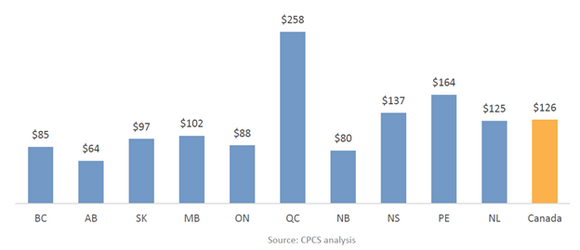The myth is true: Quebec has the worst roads
A study1 by the Canadian Automobile Association (CAA) says that Quebecers are paying dearly for poor roads, to the tune of nearly $1.4 billion per year.
“Canada’s roads are vital for commuters and businesses and to connect communities,” said Ian Jack, CAA’s Vice President, Public Affairs. “This study shows for the first time the hidden cost to drivers of below-average roads. And it demonstrates that governments would save money in the long run if they brought roads up to—not perfection—but a good standard.”
Average Annual Extra Cost of Poor Roads per Vehicle, by Province (Dollars per Year)

A worrying picture for Quebec drivers...
In Quebec, the average vehicle travels 16,685 kilometres per year and costs an extra $258 for drivers to maintain due to poor quality roads. This is more than double the Canadian average of $126.
Poor quality roads directly contribute to premature tire wear and increased fuel consumption, not to mention the inevitable additional expenses for repairs and maintenance. Damage caused by poor road conditions also tends to lower the resale value of vehicles.
“What’s worse, we’re only talking about the unpredictable costs on top of what drivers in the province already pay each year,” said Sophie Gagnon, CAA-Quebec’s Vice President, Public Affairs and Road Safety. “And since the average age of passenger vehicles and light trucks in Quebec is about eight years, we’re talking about over $2,000 per vehicle!”
...and the Quebec road network
Of the approximately 113,000 kilometres of Quebec roads assessed in the study, 12% were rated in very poor condition, 17% in poor condition, and 22% in fair condition. That means 51% of the roads failed to achieve a passing grade. The distribution is similar for Quebec’s highways and non-highway road network.
“Whether Quebecers are driving on a country road or a highway, they shouldn’t have to worry about encountering a sudden hazard or their vehicle suffering premature wear and tear that they then have to pay for out of pocket every year,” added Gagnon. “Today we’re putting a number on the direct cost for drivers for the first time, but we’ve been advocating for a quality road network for all users for a long time.”
Possible solutions
Previous reports from the Canadian Infrastructure Report Card2 have estimated the total replacement cost of Canada’s fair, poor, and very poor roads at $125 billion.
That’s a huge chunk of change, but there are things that can be done to quickly improve the situation and, by extension, reduce the financial burden on governments, municipalities, and drivers alike.
- Pavement preservation and preventive maintenance: Prevention is always better than cure, and when it comes to road maintenance, this is especially true from a cost perspective.
- Rapid response: Governments must act quickly to fill potholes and other major surface deformations.
- Strategic prioritization: Invest in targeted and preventive repairs to high-volume and strategically important roads to make a tight budget got further.
- Notify Worst Roads 2021: Have your say on the Worst Roads reporting tool that CAA-Quebec puts out online each year. Citizen participation is an effective way to help municipal public works departments determine which sections of road to prioritize.
There are no quick fixes, but maintaining good roads saves money. According to the 2019 Canadian Infrastructure Report Card3, every one dollar spent on preservation eliminates or delays $6 to $10 in costly repairs. Paved roads that are preserved as part of a strong infrastructure management program last longer and are cheaper for governments to maintain.
What about the rest of Canada?
CAA’s analysis shows that 43% of roads are not in good condition and that the average Canadian driver pays an extra $126 per year because of poor road conditions. This adds up to $3 billion in repairs, maintenance, and other related expenses, with Quebec accounting for almost half of that amount.
“A vehicle is the second-largest expense for the average household,” said Ian Jack. “Every dollar a driver has to pay to operate their vehicle is a dollar they don’t have to spend on everyday wants and needs.”
The full report can be read here.
About CAA-Québec
CAA-Quebec is a not-for-profit organization that assists each of its members by providing mobility, travel, insurance, and residential benefits, products, and services. CAA was named Canada’s most trusted brand in the annual Brand Trust Index for 2020 by the Peter B. Gustavson School of Business at the University of Victoria.
̵ 30 ̵
__________
1 The purpose of this study is to assess the cost to drivers of driving on poor quality Canadian roads. The CPCS team used data from Statistics Canada’s Core Public Infrastructure Survey, the CAA cost calculator powered by Vincentric, and a literature review on the impact of pavement roughness on vehicle operating costs.
2 Canadian Infrastructure Report Card, 2016. This report is a collaborative effort by industry associations and interest groups to provide an objective look at the state of Canada’s critical public infrastructure.
3 Canadian Infrastructure Report Card, 2019.
